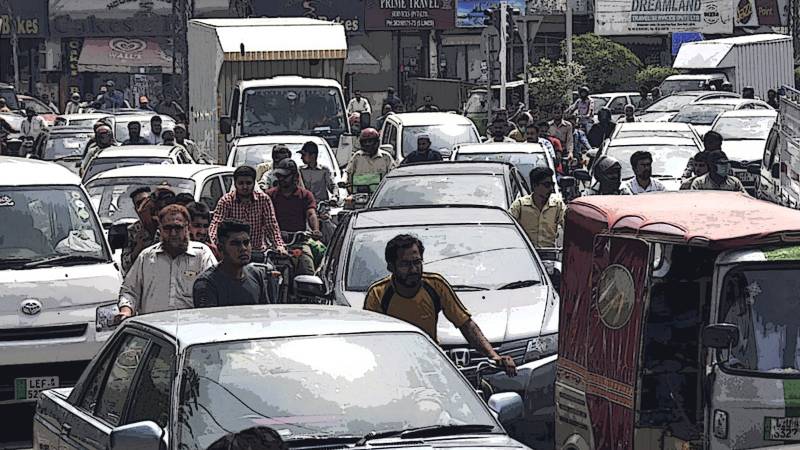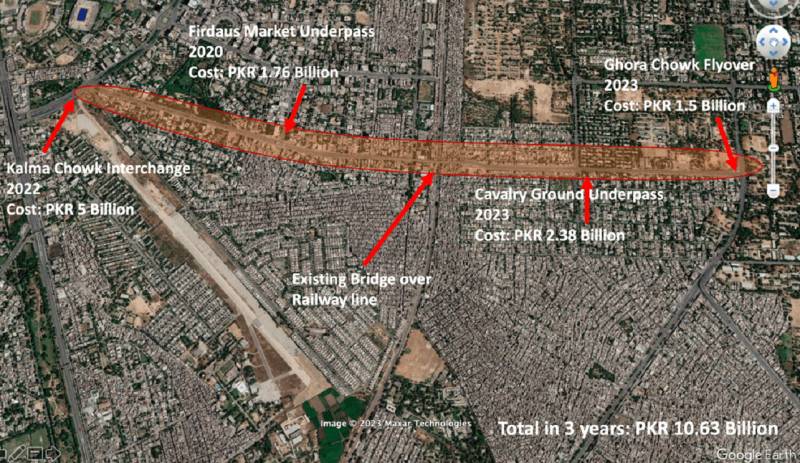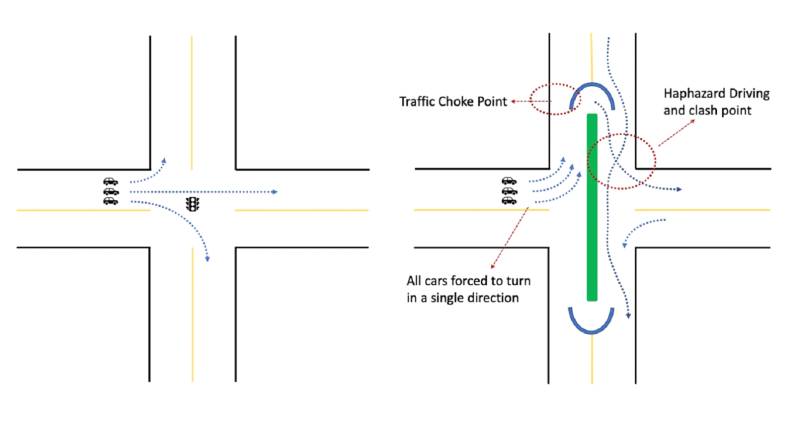
Over the past decade, the planners and administrators of Lahore have held up with pride how they have spent hundreds of billions of rupees on building flyovers, underpasses, U-turns and signal-free corridors to facilitate the fast-growing vehicular population of the city.
What the city's administration is not ready to admit, however, is how these efforts have simply failed to improve the traffic in Lahore. Moreover, they have become the primary reason for the city's worsening of air quality.
The argument the city authorities have persisted with, without citing any evidence or scientific basis, is that improving the flow of traffic will help lower air pollution. To improve the flow of traffic, signal-free corridors must be built. Both parts of this argument are incorrect.
These are important myths that have pushed the city to adopt a much-touted but equally failed project from another Pakistani city, Karachi. And as such, they must be busted.
Myth of signal-free corridors
Building signal-free corridors or car-centric infrastructure does not improve traffic flow; instead, it increases traffic. An overwhelming amount of literature from the field of transportation planning and practical experience from around the globe finds that when you build more roads or bigger roads, it attracts more cars to use those roads (Jevons Paradox).
In many instances visible around Lahore, by making wider, signal-free corridors, the city's administration has brought the movement of pedestrians to a halt. Many pedestrian crossings have been removed, forcing pedestrians who want to cross the road to use either cars or motorbikes to be able to make short trips.
In other instances, car users shun narrower roads to travel on the newly widened roads so they can encounter fewer bends and experience faster speeds. This concept, called induced demand, only increases the number of cars on the road, making the traffic flow worse, not better.
Take the example of the road from Kalma Chowk to Defence Mor in Lahore, which passes through Cavalry Ground. Upwards of Rs10 billion have been spent on this stretch of the road in the past three years in the form of new underpasses and flyovers, along with the Kalma Chowk interchange. The rationale for this expenditure was that it would help reduce traffic congestion on this road. However, this argument fell flat, as the 'highwayisation' of the road has turned this intra-city thoroughfare into one of Lahore's main Arterial roads. This is now the de-facto route for anyone travelling from DHA to the rest of Lahore and vice versa, forcing all DHA-bound traffic to use this arterial road. As a result of the increased number of users, the road has found itself to be choked by traffic more than it was before the upgrade.

If we set aside for a moment why the concept of signal-free corridors does not work, the design and implementation of the particular signal-free corridors by Lahore's development authorities is inadequate. Over the past 15 years, the authorities in Lahore have tested the concept by removing traffic signals at different junctions altogether and replacing them with U-turns. A basis for this move was that by removing traffic signals, the roads would have free-flowing traffic without needing to stop. Instead, what it created was chaos on the roads. Constantly swerving cars got in each other's way, creating unsafe driving conditions as well as haphazard driving practices.
Lahore's Traffic Police does not provide detailed traffic accident statistics, however, anyone who drives on the streets of Lahore regularly can vouch that the number of accidents on its roads have increased manifold.

Instead of learning from experience and burying its evidently unsuccessful concept of U-turns, Lahore's development authorities have doubled down on them, replicating this flawed design on every traffic signal in the city, failing to recognise that traffic signals are a good regulator for the flow of traffic, as well as offering safe pedestrian crossings.
The confusion and chaos created by these signal-free corridors have worsened the traffic congestion in Lahore. Rather than introducing efficiency and saving time and fuel for road commuters, in most instances, these projects have increased the driving time required to reach one's destination.
Second myth: signal-free gives cleaner air
For years, Lahore has been choking up with some of the worst air quality in the world. This is exacerbated in the winter months when the city's polluted air combines with fog to create the dreaded smog that leaves you breathless and blinds you.
Had the signal-free corridors succeeded in improving the traffic flow in the city, it still would not have improved the quality of Lahore's air. The reason for this is simple: the source of air pollution in Lahore, car exhaust, is not being addressed. Instead, the construction of the signal-free corridors has encouraged it. The argument that improving traffic flow will reduce exhaust emissions assumes that the number of cars will stay stagnant. This is not backed by theory or evidence, which shows that building car-centric infrastructure only encourages cars, leading to an increase in traffic, therefore, increasing exhaust emissions.
The road widening and signal-free projects approved on the argument of improving the city's air quality also do not feature any post-implementation air quality analysis to measure whether the project helped improve the city's air quality. This only shows bad faith in getting the projects approved and poor implementation strategy.
The world over, traffic engineers are realising the flaws of building car-centric infrastructure and are correcting it by reducing the size of roads, demolishing urban highways, and, in many cases, restricting private cars from accessing city centres altogether. Restricting cars and pedestrianisation leads to a more bustling local economy around pedestrianised markets, as pedestrians tend to shop more on foot and save on fuel expenses. The car-free environment is also improving air quality as well as mental health in cities actively fighting car-centric infrastructure and promoting people-centric development.
It is time for the authorities in Lahore to learn this lesson as well. Instead of building signal-free corridors, restore traffic signal junctions, introduce walkways and pedestrian crossings, and make it possible for people to make short trips on foot instead of having to take their cars. Introduce a technology-based traffic monitoring system as well as introduce tougher fines and a stricter driver's license and training regime. Introduce a well-designed public transport network to make longer trips possible without cars, as a bus carrying far more people than a car is much more efficient in reducing traffic than infrastructure interventions.

